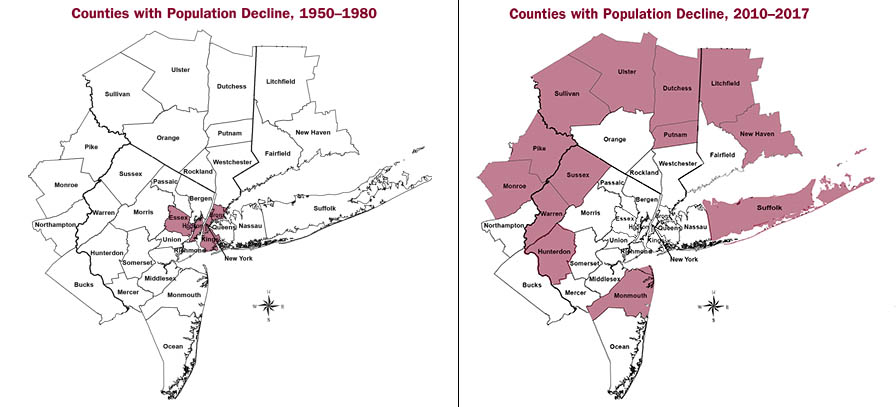A new Rutgers Regional Report, “The ‘Burbs’ Bounce Back: ‘Trendlet’ or ‘Dead Cat Bounce’?” finds that the predicted transformative demographic shifts of the early part of the decade (2010-2016)—an urban resurgence and a suburban malaise—may, in fact, be reversing. The report, authored by James W. Hughes, University Professor and Dean Emeritus of the Bloustein School; Joseph J. Seneca, University Professor Emeritus; and Will Irving, research associate at the Bloustein School, indicates that the most recent census estimates (2017) show suburban population growth surpassing that of the urban core.
“During the 2010-2016 period, the broad metropolitan region showed an almost 75 percent growth in population in the urbanized regional core, while the suburban ring increased by only 25 percent,” said Hughes. “It appears, however, that in 2016-2017 this pattern has reversed itself, with almost 62 percent of the population increase in the suburban ring.”
After 2010, the once rapidly growing outer-perimeter counties of the region slowed dramatically. The ever-expanding periphery—which had achieved almost critical mass from 1950-1980 as highly educated young adults sought to escape inner-city turmoil, poverty, crime, high taxes, deteriorating public transit, and more—became less attractive to suburban-bored young adults, empty-nester baby boomers and international arrivals as rental housing became increasingly in demand.
Key findings include:
- Between 1950-1980, the suburban ring counties in Connecticut, New Jersey, New York, and Pennsylvania nearly doubled their total population, gaining more than 5.3 million people; in comparison, the eight regional core counties in New York and New Jersey lost close to a million people.
- The suburban ring continued to grow from 2010-2017, but at one-sixth of the earlier period. During this time the regional core grew at an annual pace of more than double that of the suburban ring, accounting for 71.8 percent of the region’s total population growth.
- In a single year (2016-2017), 62 percent of the region’s total population gain was in the suburban ring, while the regional core captured just 38 percent.
- The longer-term trend (2010-2017) shows the regional core as the locomotive of the region’s demographic train.
- The highest growth totals in the suburban ring (2010-2017) were achieved by the five inlying counties closest to the regional core; at the same time 13 of the 27 (48%) suburban counties lost population in this time frame.
- The metropolitan outer rim, once the demographic “hot spots” of population growth, accounted for almost all of the population loss from 2010-2017. But in 2016-2017 the losses generally abated and several even saw modest growth.
The authors cautioned against generalizing the comparison of a three-year period to a 30-year period in a previous 2014 Rutgers Regional Report, “The Receding Metropolitan Perimeter.” Offering the same careful outlook in the most recent report, they also indicate that if the time frames do indeed represent two fundamentally different eras—namely, suburbanization/urban decline versus re-centralization/perimeter contraction—then a transformative regional change may be underway that is only just now beginning to be revealed.
The authors put forth many possible factors that may be responsible for the change, many of which are discussed at more length in the book New Jersey’s Postsuburban Economy (Rutgers University Press, 2014) But at this time, determining whether the end result will be a long-term, fundamental shift or a temporary change in growth dynamics and population distribution within the region will be difficult.
The Rutgers Regional Report produces formal studies on regional and state economies, demographics, housing markets and other key public policy issues and is used extensively by the state’s planning and public policy communities. The full report is available at https://bloustein.rutgers.edu/reports/rrr/RRR39.pdf.
To interview the report’s authors, contact James W. Hughes, jwhughes@rutgers.edu, 848-932-2827 or Will Irving wirving@ejb.rutgers.edu, 848-932-2816.

